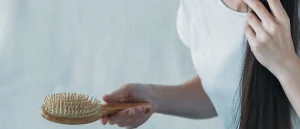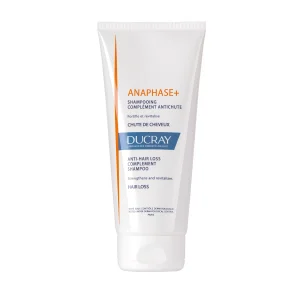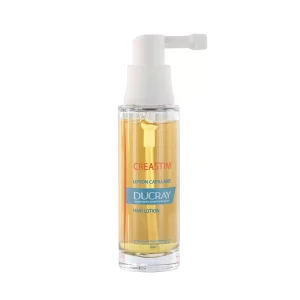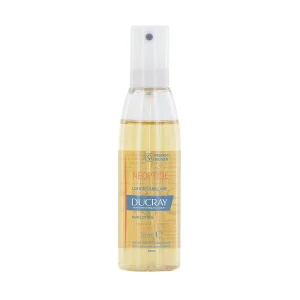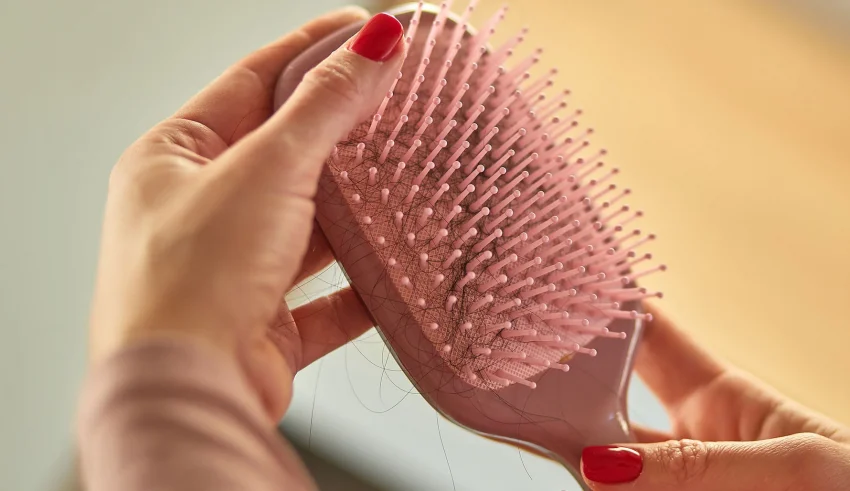
Most people think of hair loss as a male problem, but it also affects at least a third of women. However, unlike men, women generally lose their hair without going bald, and the problem may have several underlying causes. Hair loss in women can be distressing and have a negative impact on self-esteem. That’s why we asked the dermatologist Dr. Amal Sweidan to give us some strategies and treatments for managing this problem.
What is hair loss in women?
Hair loss in women is simply a significant and unexpected loss of hair. In general, humans lose between 50 and 100 hairs per day. Hair shedding is part of a natural balance: some hair falls out while others grow in. When the balance is interrupted, that is, when hair falls out and less hair grows in, hair loss occurs.
Hair loss can affect any girl or woman. However, according to Dr. Amal Sweidan, it is generally more common in:
- Women over the age of 40
- Women who have just had a baby
- Women who have undergone chemotherapy
- Postmenopausal women
The signs of hair loss in women are
- Seeing more hair falling out of brushes and pillows every day
- Seeing patches of missing hair from the top of your head
- Seeing hair break off
What are the causes of excessive hair loss in females?
Dr. Amal Sweidan lists the main causes of hair loss in women: medications, physical or emotional stress, hormonal imbalance, and vitamin deficiencies.
- Medications
Some medications can cause chronic hair loss. In particular, those used to treat high blood pressure, cancer, arthritis, and depression are known to cause hair loss problems.
- Physical or emotional stress
When you experience a stressful or traumatic event, such as a divorce or a death in the family, you may notice a temporary halt in hair growth as your body uses its resources to help you cope with this incident.
- Hormonal imbalance
Women may experience hair loss during menopause due to the decreased production of the hormones estrogen and progesterone. Some women may even experience hair thinning and hair loss after stopping the hormonal birth control pill. Why? Again, hormonal changes of any kind, especially a decrease in estrogen levels, can temporarily disrupt the hair life cycle.
When it comes to postpartum hair loss, hair shedding usually peaks about four months after giving birth. The excessive shedding is caused by falling estrogen levels.
- Vitamin deficiency
Maintaining healthy hair depends on a solid diet. Notably, deficiencies in iron, zinc, vitamin B3 (niacin), and protein have all been linked to various types of hair loss.
How to treat hair loss in women?
1- Eat the right foods
Your diet has the potential to improve hair growth. Choose foods rich in biotin (eggs, fish, meat, and nuts), omega-3 fatty acids (salmon, tuna, nuts, and chia seeds), and vitamin D (orange juice and yogurt).
2- Take hair supplements
You can ensure nutrient intake by eating a whole food diet of colorful fruits and vegetables. Alternatively, we recommend you take multivitamins specifically designed for hair, skin, and nail health.
Supplements for hair loss in females are essential for hair health. Dr. Amal Sweidan lists the most important nutrients for hair loss in women:
- Vitamin A
- Vitamin B complex
- Vitamin C
- Vitamin D
- Vitamin E
The best product for hair loss in females is Ducray Anacaps Food Supplements which fight hair loss and strengthen hair and nails. Each capsule delivers the necessary nutrients to give strength and vitality to the hair bulb and nail matrix.
3- Say goodbye to bleaching and embrace the natural beauty
Ditching your favorite hairstyles requiring bleach, heat and other harsh chemicals could be the key to ending your styling-induced hair loss. It may be difficult at first, but giving up perfectly bleached hair will prevent hair loss.
4- Use an anti-hair loss shampoo
Regardless of the cause of hair loss, it is necessary to use an appropriate shampoo to prepare the scalp for optimal absorption of anti-hair loss lotions. It is also important to use a fortifying shampoo to restore strength and volume to the hair.
When looking for a good over-the-counter hair loss shampoo, look for a product with ingredients that curb hair loss like monolaurin.
Ahead, discover one of the top products for hair loss in women.
Ducray Anaphase + Anti-Hair Loss Complement Shampoo
5- Apply a hair care product
When your hair is in a vulnerable phase due to increased hair loss, dullness or breakage, make sure that your hair care products are carefully formulated for thinning hair.
It’s important to know that there are two types of hair loss: occasional and chronic hair loss. Seasonal and hormonal changes, physical stress, or psychological stress can trigger excessive and sudden hair loss. Unsuitable hair treatments (excessive brushing, overheated hair dryers, aggressive shampoos, etc.) are also responsible for occasional hair loss.
On the other hand, chronic hair loss is characterized by a progressive decrease in hair density. It occurs progressively and is particularly difficult for women.
A topical treatment specially designed for women must be used. Check out these two products.
For occasional hair loss:
Ducray Creastim Anti-Hair Loss Lotion
For chronic hair loss:
Ducray Neoptide Anti-Hair Loss Lotion for Women
6- Manage your stress
Studies have shown that stress can be a major factor in hair loss. It can aggravate hair loss due to another underlying condition and trigger a vicious cycle of further hair loss. Try stress-reducing activities such as yoga, meditation, or breathing exercises.
7- Style your hair with care
Wondering what you can do about female hair loss? Relax! Tight ponytails, hats, scarves, braids, and bandanas will pull on the hair and cause it to fall out through a process called traction alopecia. The gradual, constant tension irritates the scalp and can cause hair loss.
What are other hair loss solutions for women?
Dr. Amal Sweidan suggests using minoxidil, corticosteroids, PRP, hormone therapy, and hair transplantation.
- Minoxidil
Minoxidil is an over-the-counter medication that comes in liquid and foam form for topical use. It is intended to be applied daily to the scalp and should generally be used long-term, for months and years, to effectively prevent hair loss and promote hair growth. For hair loss in women, it is recommended to use minoxidil at 2%, while for the treatment of hair loss in men, they can use the 5% formula.
- Corticosteroids
Women suffering from hair loss may consider treatment with corticosteroids injected into several locations in the affected area. Hair regrowth can be seen as early as four weeks, and the treatment can be repeated every four to six weeks.
- PRP
PRP (platelet-rich plasma) therapy for hair loss is a three-step medical treatment in which a person’s blood is collected, processed, and then injected into the scalp to increase the blood supply to the hair follicle.
- Hormone replacement therapy
Hormone replacement therapy involves taking female hormones, usually estrogen and progesterone, at the same time.
- Hair transplant surgery
Hair transplantation is a surgical procedure in which a doctor removes hair from a portion of the scalp and transfers it to areas of the scalp where it is thinning.
Last Updated on April 16, 2024
